 |
330 GT Registry |
 |
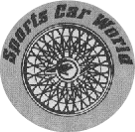
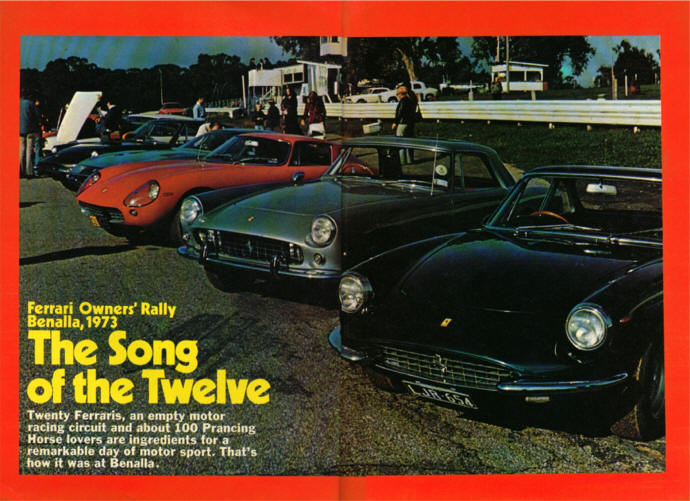
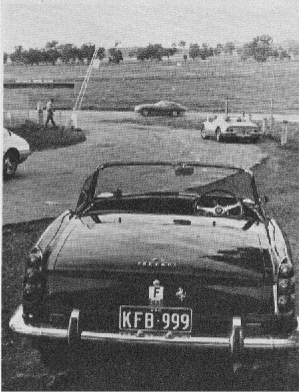 WAAAAAH . . . rap, waaaaah
WAAAAAH . . . rap, waaaaah
That’s how a Ferrari Daytona sounds when its snap changing from third to second under full braking for the S-bend which leads into Winton circuit’s pit straight.
I’m watching spellbound through the viewfinder of an unfamiliar Nikon, determined to stop the silver projectile on film as the driver unleashes 352 thunderous bhp on the bumpy bitumen, five yards from my feet.
Standing alone, I see the puff of blue smoke which accompanies a Ferrari gearchange and there’s a spine tingling crackle from four exhausts.
He’s into the bend and looming up in the camera frame . . . closer and closer . . . only a second away now...
A hand touches my elbow lightly and I’m distracted at the crucial moment but I press the button anyway. God knows where the camera’s pointing.
I whirl to unleash fury on the person who’s disturbed me and I’m confronted by a small tubby, prosperous looking man in a brown car coat who says in the soft, confiding tone of the educated English, “Don’t waste your time, old man, you can’t photograph a sound”.
At the time, I’m ropable, furious at having my picture spoilt. Doesn’t he know that was my second last color shot?
And to make matters worse, the Daytona’s been taken off the track and it’s been replaced by an equally high born, but less photogenic 330GT. Damn.
Much later it dawns on me the little man is right — the sound is everything.
That’s how I
remember the Ferrari Owners’ Club rally at Benalla — in a series of small,
separate and highly emotive scenarios.
The little man, I, and perhaps another 60 people have congregated at Benalla in
Victoria’s mid-north to drive, talk about, eat, sleep and live Ferrari for three
days.
The nucleus of the event comes on Sunday when everyone congregates at a motel at 10 am to drive through Benalla to Winton, the short, tight track about three miles out of town towards Sydney.
They wheel out about 10.30 after all engines have been thoroughly warmed, and they stop in a 20-car line in the main street for members to take photographs.
Some cars are idling, some throttles are being blipped and some are being run at a constant few thousand revs to get that oil thoroughly warm.
The noise is loud. . - and mind bending. It’s gripping — like listening to a complex, compelling piece of music, and I forget to take any photographs.
Suddenly they’re away again and burbling down the main street — they in their Ferraris and me in my faithful Datsun SSS — following at a respectful distance.
You see the effect of it all on the townspeople.
Two old men sitting on ? bus seat put down their Sunday Telegraphs and just gape — their mouths open. A service station attendant stares riveted — his eyes flickering from the front to the back of the line — until he feels petrol from an over full tank splash down his leg and onto his shoes.
And somebody’s old black dog, that’s been scavenging a newspaper parcel in the gutter, rushes inside the picket fence of his owner’s house and watches wide-eyed with his nose pressed between the slats.
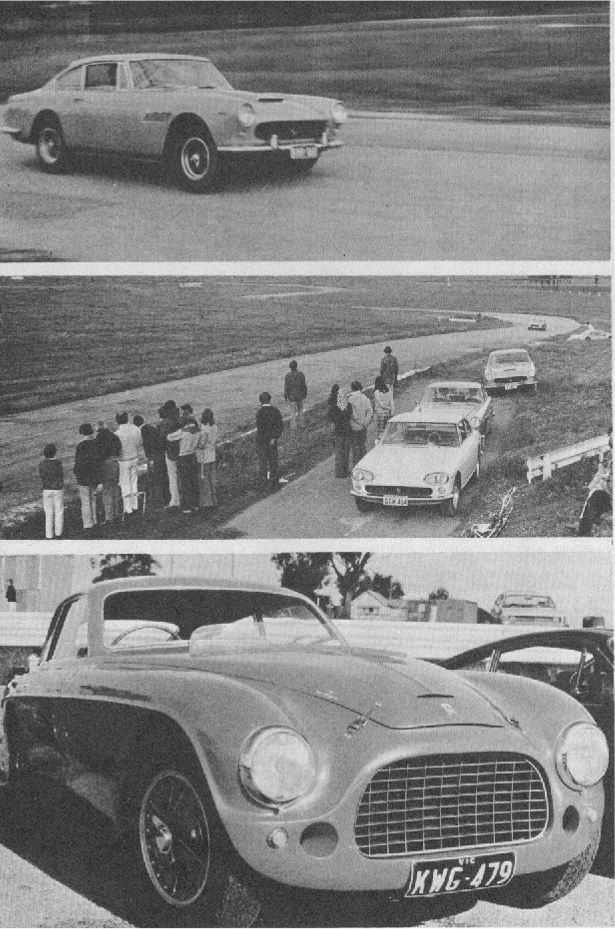 We arrive at the circuit,
trailed at a distance by one of those gaudy Victorian police cars — its driver
just as rapt as the rest of us.
We arrive at the circuit,
trailed at a distance by one of those gaudy Victorian police cars — its driver
just as rapt as the rest of us.
They line the 20 Ferraris up to be judged for the concours and for more photographs. It’s been raining and you have to stand up to your shins in wet grass to get a good picture.
There’s great variety in the cars — everything from Ian Ferguson’s 1951 225S ex—works GT car to the 1972 246GT Dino brought up from Melbourne by Ralph Lowe. There are a dozen different models all told.
The “best presented car” award is eventually given to Ivan Butterworth’s superb 356 GT 2 plus 2, which someone tells me is used for normal town driving and has done 60,000 miles in four years.
Ferrari owners, I find, are a group of super enthusiasts. They’re not especially keen to be publicised and they’re harder to approach than other marque groups, but their dedication to their cars and their knowledge about them is awesome.
George Luk, the club president stands on the Winton starting grid, compiling a list of the cars that made it. He’s taking down the details of Sydneysider Les Miller’s car — a 330 GT 2 plus 2.
George: “Has it got five speeds, or four and overdrive, Les?”
Les: “Overdrive”.
George: (to himself, looking down at his list) “Right then, that makes it a ‘64
model”.
To know the details of each model from year to year in a marque with as many variations as Ferrari is amazing. Yet such utterances are common among Ferrari owners.
By now the drivers have been restlessly eyeing the track and are anxious to be under way.
They start to circulate fairly slowly with about 50 yards between them, slowly building up pace. George Luk still stands on the starting grid, tall, athletic and not looking like a dental surgeon at all, impressing on drivers the necessity for going slowly and keeping plenty of space between cars.
I get into the passenger’s seat of Graeme Quinn’s 250 GTE and I just have time to realise that these are real bucket seats when he lets in the clutch.
Winton’s really only a two gear circuit in a road Ferrari — even the earliest ones. You use first only to take off and second everywhere, except for the main straight where you might get it into third for a few seconds down the main straight when you’re touching about 90mph.
The clatter of the
valve gear, and just the sheer level of noise strikes you first as the 60 degree
V12 winds beyond 5000 rpm.
The corners are all tight at Winton and you’re surprised by the amount of body
roll in the 250 GTE as you round the first one.
There’s very little understeer though, and in fact the tail starts to skitter
outwards until the power comes on and then, bang, it’s all straight again and
we’re away with a kick in the back and a bark from the twin exhausts.
Marvellous.
I get out after a
while and stand on the verge in the middle of pit straight, savoring the
movement, the sights and the sounds.
Next to me is a young bespectacled fellow watching Ian Ferguson’s 225S
circulating and as it passes us he turns to me and with a familiarity born of
common enthusiasm for fine cars he speaks softly.
“The song of the 12”, he says, “there’s nothing quite like it, is there?” and stares into the distance at the red Ferrari’s rapidly diminishing tail.
We begin to converse, first in low, almost reverent tones, then louder, more enthusiastically, and our exhilaration grows as we talk about our common enthusiasm — Ferrari.
The words come faster and faster until after 10 minutes we’re laughing and enthusing like children.
His name is Aitor. He’s been one of the concours judges and is the closest person to a Ferrariophile I’ve ever met.
He tells me about
times when he was living in London when he’d travel halfway across the city just
to look at a “Fazz” for sale.
“I’d talk to the bloke who was selling it, sit in it, look at it, walk round it,
take pictures of it and then I’d go home.
“Hell, half the time I wouldn’t even hear it run, but I’d be happy”.
When I ask him why
he hasn’t got his own Ferrari he hesitates, looks way over the Benalla hills and
tells me he’s saving.
He explains about the Commentadore’s early love of the sound, the Packard Twin
Six and the V12 Grand Prix Delage made, and how this led him to speak of the
“song of the 12” and eventually to build engines of that configuration.
We could talk for hours, but someone yells, “Oh, Gawd, here comes Lou in the mobile soup kitchen.”
“Lou” is Lou Molina, restaurant owner, ex-racing driver, owner of a 250 GTE Ferrari and flamboyant character, par excellence.
As we watch he comes thundering over the rise in the middle of the straight, snap changes to second with a crackle from the exhausts and bears down on the bumpy right hander 150 yards farther on.
You’d swear he’s left the braking too late, but with a dab he’s got her a touch sideways, then tail has swung wider and he’s powered through the way only a driver with as many racing miles as Lou could do it.
He does it maybe five times more, varying only by fractions of a second in lap time; very, very good if you know anything about those wicked Winton bends.
Lou knows, he’s run there in a six-hour race years ago, driving an MGTC special.
Then he slows down, the Ferrari burbles off the track and Lou gets out, moustache bristling, and looking like the archtypeal Spitfire pilot — waxed handlebar and all.
Or like Australia’s version of Duncan Hamilton — that eccentric British driver of Ecurie Ecosse (and many bingles) fame.
Peter Menere comes charging past in his jet black 400 Superamerica spider.
He’d much rather you didn’t call it a “Superamerica” though — he’s gone to great pains the previous day to explain to you, and anyone else at hand, that the Italian name for the car is “Superfast”.
Peter is one of several people I have approached for a drive and who have firmly refused.
“No one drives my car except me,” says Peter, with a bit of a glint in his eye.
You respect him for it, in a way.
Peter has one of the most potent cars here, reputed to be capable of late 14 second standing quarter miles and still able to top 150 mph.
He’s another veteran racing driver, having campaigned a Bugatti Type 35 in the days of Curley Brydon and the up-and-coming David Mackay. Bathurst was his circuit, he says.
He looks the part too, hunched down in the seat with his small brimmed cloth hat pulled well onto his head, and the big wheel barely a foot from his chest.
I climb in with him. The 4-litre 12 really hauls as we power off up the straight. This car feels very big and brutish — it’s got a bulbous scoop sitting in the middle of the bonnet — but it’s surprisingly flat in the corners.
You’re mashed back in the seat as the power comes on down the straight, but Peter’s still got time for a brief shouted comment on the tightness of the circuit.
After lunch — steak, chops and wine — I approach Ian Ferguson for a ride in the superb 225S which was raced in 1951 and heralded on its arrival in Australia in 1955 as “Australia’s fastest car” by SCW.
Ian isn’t sure, but he thinks his car was part of a works team in the Pan America race of 1951.
It’s a 2.7 litre car. In 2-litre form, the car gave Ferrari his first Le Mans win, in the hands of Luigi Chinetti in 1949.
Ian has driven the car from Melbourne (his wife has followed in his other Ferrari) and it’s already done dozens of laps around Winton with Ian and other people’s in the seat.
Outside, it looks just marvellous — a mixture of both ageless and classic lines, but inside it’s hardly stylish.
Inside it’s spartan and there’s- unpainted drilled metal everywhere, two thinly padded buckets, the essential controls and nothing else.
The engine noise is absolutely unreal.
From outside, the car has the loudest exhaust of the 20 cars here, yet in the cockpit you’re battling to hear it at all — it’s being drowned out by the threshing of cam drive chains and the chatter of valve gear.
The cogs in the gearbox are all straight cut, and of course there’s no synchromesh.
Bang! The clutch is OUT and we’re off down that straight amid frenzied mechanical noise from the engine and incredible gear whine.
Before Ian can grab second, we’re into the first bend, with the battle between bumps and hard suspension keeping him busy at the big wheel. We’re nearly pointing straight as he plants it and instantaneously the rev counter needle’s reached the redline and it’s time to . . . graunch . . . change to second.
My nose is working overtime. There’s smoke rising through the floorboards at every gearchange (“It’s got a new clutch in it,” says Ian), there’s a smell of burning Castrol, hot brakes, rubber, fuel — it’s all there.
Ian gets quick and you start finding out just how much the power matters in this car’s cornering.
Lines are a bit hard to maintain because the bumps cause the rock hard suspension to throw the car all over the place, but when that power goes on, the 225 seems to reach down and grip the road . . - and it’s away.
The last two laps
have been quick — and Ian’s pleased — you can tell by the jaunty angle of his
cigar.
We stop and he promises to let me drive his 250GTL (Lusso) later — probably the
best looking Ferrari ever made — so I’m feeling pretty good.
The big eaters are still clustered around the barbecue, so a couple of Porsche 911 owners, who’ve been sitting behind the spectators fence champing at the bit, take the opportunity for a squirt round the circuit..
They’re obviously intent on proving that German beats Italian, but they should have stayed at home because there are only snide remarks and scathing references to “Volkswagens” from the partisan crowd.
However, somebody pours oil on the troubled waters and an international incident is averted. The Porsche men are soon drinking wine with the rest.
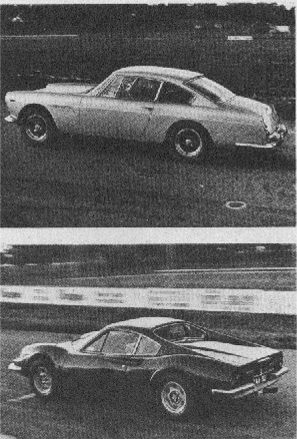 Every Ferrari driver gets a
turn on the track on his own and the Dinos are clearly the fastest cars, though
it’s relative driver ability that’s most sharply defined on this tight,
challenging circuit.
Every Ferrari driver gets a
turn on the track on his own and the Dinos are clearly the fastest cars, though
it’s relative driver ability that’s most sharply defined on this tight,
challenging circuit.
At last, as the sun begins to sink, Ian says I may drive the Lusso.
The 250 GT Berlinetta is 10 years old now, but the lines don’t tell you that. All they say is that it’s a classic, very special motor car and that it’s a Ferrari.
The body design (you can’t say “styling” when you’re talking about a Ferrari) is timeless.
Less than 450
Lussos were made between 1962 and 1964 and they’re one of the most sought after
Ferraris of all these days.
Ian’s car has the 250 (3-litre) engine and it produced 290 bhp at 7500 rpm,
travels from 0-100 mph in 19.5 seconds and then runs on to a top speed of 150
mph. Try that in your lighter, bigger engined fussier XU-1.
The starter gives that strange, turbine like whirring that’s peculiar to the prancing horse, and then the engine starts quietly and settles down to a 900 rpm idle — smooth and even.
“Surely this car doesn’t produce nearly 100 bhp/litre,” I say to Ian, but he doesn’t hear me. It does, though.
The Lusso is well appointed and comfortable and has a surprisingly un-Italian driving position. I have no trouble fitting my longer than average legs in.
In with the clutch
(surprisingly soft and docile but heavy, though) and we’re idling down the
straight at around 1500 rpm in first.
The accelerator’s quite heavy so I give it a prod, there’s a muffled bellow, and
the Lusso surges off with me barely prepared for this sort of response.
We don’t get out of second gear except in the main straight when we’re in third for a few moments.
The car corners as
though it’s on rails. The steering’s fairly heavy — you have to be decisive —
but the response is faithful.
You approach a corner too fast. You turn the wheel and round comes the car; you
turn it some more and there’s a more response. My God, in anything else you’d be
in the bushes.
You’re about two thirds through the bend so you feed in the power and the tail squats, no, dammit, the whole car squats, and suddenly you’re pointing straight and bursting up the straight, congratulating yourself on a good exit from a bad corner.
A Ferrari like
this is actually an easy car to get into and drive normally, but you’d have to
practise and improve and polish for a long, long time before you ever reached
its limits.
A few more laps and things are becoming more fluent. The pedal relationship is
marvellous for heel and toeing, the steering wheel position and the effort
needed to turn are just fine for me. The relationship between engine revs and
gear ratios and clutch take-up is perfect so your gear changes are dead smooth
every time. What a car.
There’s an unborn thought pushing towards the forefront of my mind as I go on, guiding the car around, feeding power in and only feeling the crush of cornering forces and the responsiveness of the brakes, until I feel I’m getting to know the very soul of the car.
The elusive thought bursts upon me.
This Ferrari was designed and built for me. For me and for the thousands like me.
Aren’t I a person who values performance, handling, classic lines, mechanical refinement and breeding above all else? Yes.
Aren’t I a person who loves to drive for miles and hours just for the pure hell of it? Yes.
I see it all now. I see the Ferrari mystique. This is the Commentadore’s great plan. He’s built his cars to yell “desirable” at you louder than anyone else’s through life-long dedication and exceptional Italian cunning.
By the time I’ve wheeled the Lusso off the track and onto the grass, I’ve decided that somehow, someday I must own a Ferrari.
But for the moment I’m like Aitor — I’m saving.
STEVE CROPLEY
SPORTS
CAR WORLD, October, 1973